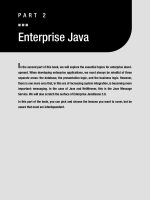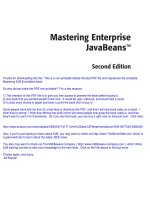Enterprise Java Beans
Bạn đang xem bản rút gọn của tài liệu. Xem và tải ngay bản đầy đủ của tài liệu tại đây (6.13 MB, 60 trang )
Enterprise Java
Beans,
an Introduction
Barbara Dellen
Jeff Thomson
Contents
•
Overview: What are EJB’s?
•
EJB Fundamentals
•
EJB’s and Gemstone
The Model
•
Enterprise JavaBeans are Java
components that fit together in a standard
way.
•
The container provides a portability layer
that lets anyone’s beans operate in
anyone else’s container.
Containers
•
Containers are software receptacles that
know how to communicate with and
manage the beans.
–
The container places itself between the
client and the bean. This gives it the
opportunity to implement services many
developers don’t want to worry about.
Container Services
•
Some services that can be provided by
the container include:
–
Persistence management
–
Transactions
–
Concurrency
–
Thread management
–
Security
Container Vendors
•
Many vendors have already supplied
containers for EJB and their products.
Among them are:
–
IBM
–
WebLogic
–
Sybase
–
Oracle
–
CORBA Object Request Brokers such as
Inprise (Borland)
Infoworld’s Example
•
Infoworld developed a sample
application for EJB using:
–
WebLogic’s Tengah Java application server
as the container
–
IBM as the server
–
Oracle as the database
•
The application’s use of servlets to act as
clients to the EJB’s allows for browsers
that don’t support Java.
Example continued
•
The sample application was a J-Store that
simulated an online-shopping service
–
EJB handled the business objects
–
Java servlets and JavaPages take care of the
page transmission and display logic
–
Application authenticates users and lets
them browse GIF images, load them into a
shopping cart
–
and tallies up the sale.
Behind the scenes
•
The container interposes itself between
the client and the bean.
•
Beans that a client creates do not expose
their functions directly to the client
•
The container exposes the methods of the
remote interface
•
Which is assembled ahead of time by the
container vendor.
This is known as “wrapping” the object.
The Container
•
You can specify to the container at
deployment time how to treat your
components
•
This is called Declarative programming.
Unwrapping
•
To find the bean’s home interface, the
client must appeal to the container via
JNDI - Java Naming and Directory
Interface.
Back to the Example
•
The application’s server bean runs alone
inside the Tengah container
•
But EJB lets multiple beans run side by
side in the container.
•
EJB also allows multiple instance of the
same bean.
•
Also, EJB allows multiple containers to
run on a server.
Bean programmers don’t have to worry about
the number of clients activating a bean.
Session Beans
•
Session beans are used by one client
only, two clients may not access the
same instance of a session bean.
•
Session beans are lost in a server crash.
Two Session Beans
•
Stateless Beans
–
A stateless bean looks the same to a client
before and after operation.
•
Stateful Beans.
–
A stateful bean is semipersistent
–
The developer can have them swap their
parameters to disk, passivate the bean, then
later reactivate it.
Entity Beans
•
Entity beans survive if the server crashes.
•
Multiple clients can access a single entity
bean via multiple instances.
•
The container makes sure each instance
is bound to the current data and passes
info to the proper client.
References
Tom Young and Yun Wang,
Mixing Sun’s Magic Beans,
Infoworld Publishing Company,
June 29, 1998.
www.infoworld.com/cgi-bin/displayTC.pl?/980629analysis.html
EJB Architecture
Client
EJB Server
Container
Home Object
EJB Object
EJB Object
enterprise Bean
enterprise Bean
Remote Interface
Remote Interface
Home Interface
Enterprise Bean Types
•
Session Beans
–
Executes on behalf of a single client (not
shared)
–
Updates shared data in an underlying
database
–
Does not represent directly shared data in
the database
–
Is removed when the EJB server crashes
Once again: EJB Types
•
Entity Beans
–
Represents data in the database
–
Is transactional
–
Allows shared access from multiple users
–
Long-lived
–
Survives crash of the EJB server
Roles in EJB Development
•
Client
•
Enterprise Bean Provider
•
Container Provider
Session Beans: client view
Client
Container
BankBeanHome
:BankBeanRemote
:BankBean Remote
:BankBeanRemote
AirlineBeanHome
:AirlineBeanRemote
:AirlineBeanRemote
BankBean class
AirlineBean class
Client view on a session Bean
•
Non-persistent object that implements some business
logic running on the server
•
Access it through the session Bean’s remote interface
•
EJB object is RMI-object & implements session
Bean’s remote interface
•
EJB object lives in container
•
Container provides security, transactions, swapping
etc. transparent to the client
•
Container may handle multiple EJB classes
•
Client does never communicate with the actual session
Bean object but with the corresponding EJB object
The EJB object
•
Provided by the container
•
Supports enterprise Bean’s remote
interface
•
Delegates invocation of a business
method to the enterprise Bean instance
•
Supports methods of
javax.ejb.EJBObject interface (getting
the object’s container, etc.)
Class Diagram for a session Bean
BankBean
BankBeanRemote
<<Interface>>
javax.ejb.EJBObject
<<Interface>>
BankBean implements the
business methods of the
BankBeanRemote interface.
javax.ejb.EJBHome
<<Interface>>
BankBeanHome
<<Interface>>
javax.ejb.SessionBean
activate()
passivate()
remove()
setSessionContext(SessionContext)
Session Bean
•
Implements business methods of the
Bean’s remote interface
•
Implements the javax.ejb.SessionBean
interface
–
activate()/passivate() signals when the Bean
is about to be activated/passivated by the
container
•
Implements ejbCreate(…) methods









